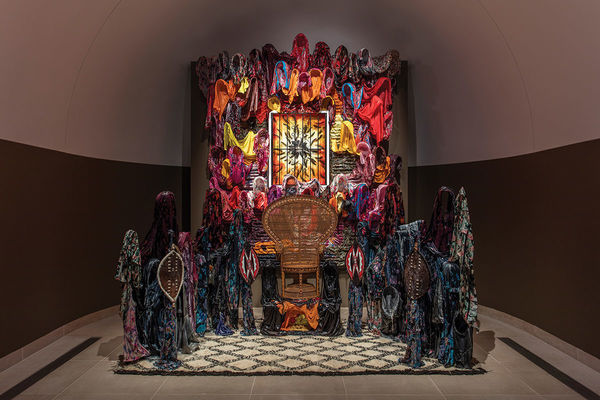
Kevin Beasley (American, born 1985)
Chair of the Ministers of Defense, 2016
Polyurethane resin, wood, acoustic foam, jeans, trousers, du-rags, altered t-shirts, altered hoodies, guinea fowl feathers, wrought iron window gate, vintage Beni Ourain Moroccan rug, kaftans, housedresses, Maasai war shields, Zulu warshields, and vintage peacock rattan chair
On loan from The Joyner/Giuffrida Collection and The Rennie Collection
February 4 – December 23, 2021
This immersive installation explores ideas of power and race in America through theatrics reminiscent of the Roman Baroque. Here, renowned conceptual artist Kevin Beasley calls into focus Black liberation movements and ongoing imbalances of power experienced by Black Americans and marginalized men and women of color. The work maintains a formality often employed in religious imagery and in art intended to convey the divine right of leaders.
An empty, rattan “peacock” chair is at center; above is a house window clad in protective iron bars, evoking a stained-glass window. Flanking are archetypical Maasai and Zulu warrior shields, icons of African might. Surrounding are vaguely figurative, resin-infused sculptures made from t-shirts, housedresses, and du-rags — all items associated with contemporary urban culture.
Beasley juxtaposes icons from the history of art with a specific flashpoint in twentieth-century American culture. Specifically, Gian Lorenzo Bernini’s monumental Baroque altarpiece, the Cathedra Petri, in the apse of Saint Peter’s Rome, has been reinterpreted through the lens of a carefully staged photograph of Black Panther Party founder Huey P. Newton (1942-1989). The sculpture, more than merely representing Peter as the first pope, symbolizes the papacy as a proverbial seat of power.
Blair Stapp’s 1968 photograph of Newton, entitled Huey Newton, Black Panther Minister of Defense, shows Newton armed with rifle and spear. Newton’s leadership is underscored through his demeanor, pose, and clothing. In an apparent quote of Jean-Auguste-Dominique Ingres’s 1806 portrait of Napoleon I on His Imperial Throne, Stapp’s photograph documents the intentional visual construction of Black Panther power that Huey Newton and
his collaborators orchestrated to echo enthroned might.
Although the previous works of art are separated by time and place, subject and material, all are staged symbols of power. Beasley judiciously reaches back through history to create an installation that allows the viewer to consider notions of power and how it is presented, held, challenged, exhausted, or toppled. The space created waivers between indications of the domestic to suggestions of the sacred. Bathed in the dramatic light of the theater, Chair of the Ministers of Defense is an open stage in which to consider the circumstances and
conventions used by those in control and those who challenge their authority.
Based in New York City, Kevin Beasley has emerged as among the most insightful and distinguished American artists of his generation. Through sculpture, installations, and performance art, he has captivated audiences by
exploring challenging topics that address history, social injustice, power dynamics, and, ultimately, the dignity of Black men and women in America. Born in Lynchburg, Virginia, in 1985, Beasley attended the College for Creative Studies in Detroit (BFA, 2007) and Yale University School of Art (MFA, 2012). He captured critical attention at the 2014 Whitney Biennial and presented a solo exhibition in 2018. He has exhibited at the Museum of Modern Art, the Studio Museum, Harlem, and the Solomon R. Guggenheim Museum. Beasley’s work is included in many of the most important public and private collections across the United States and England, including The Joyner/Giuffrida Collection and The Rennie Collection.
This exhibition was made possible through the generosity of Pamela J. Joyner and Fred J. Giuffrida ND’73 and the Humana Foundation Endowment for American Art.